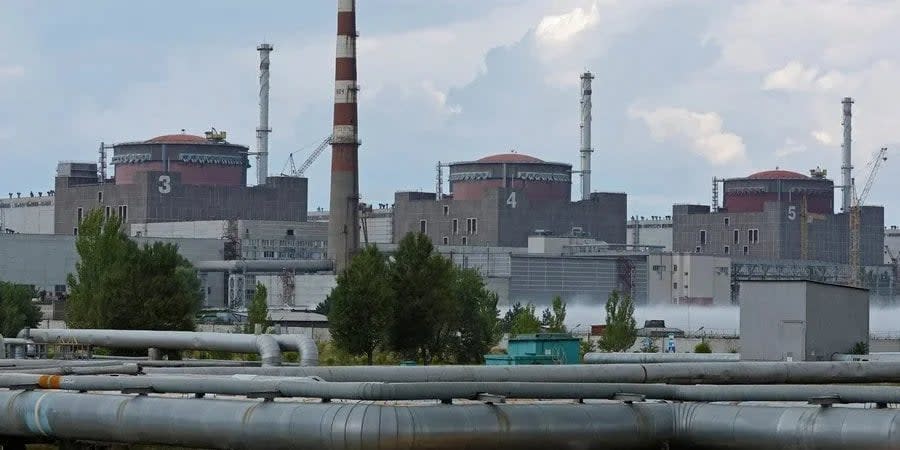What will happen if Russia blows up the Zaporizhzhya Nuclear Power Plant

- Oops!Something went wrong.Please try again later.
Russia is considering carrying out a terrorist attack at the occupied Zaporizhzhya Nuclear Power Plant (ZNPP) and “has prepared everything for this,” Ukrainian military intelligence chief Kyrylo Budanov and President Volodymyr Zelenskyy warned on June 25.
Budanov said that Russians had deployed explosives near four of the plant’s six reactors.
In turn, Zelenskyy informed Ukraine’s partners about Russia’s actions.
“I told them about the information we have, our intelligence has, about Russian scenarios with the mining of the Zaporizhzhya NPP, which, for the terrorists, has been confirmed,” the president said.
NV explains in detail the current situation at ZNPP and what might happen in case of a possible terrorist attack by the Russians.
The ZNPP has six reactors, all of which are currently shut down, none of which are operating in power generation mode. The Russians have deployed military equipment, weapons and ammunition in reactors #1, 2, 4. At the same time, reactor #5 is in hot shutdown mode, while reactors #1-4 and 6 are in cold shutdown mode.
Cold shutdowns minimize the risk of a disaster occurring in the event of a missile strike or other emergency situation. In this mode, the temperature of the first circuit of the reactor decreases from 275 to 70 degrees Celsius.
Reactors in cold shutdown, in case of a complete power outage, have much more time before a meltdown occurs in their active zone. In a hot shutdown, reactors are likewise not generating power, but can be quickly flipped to active operation. When operating, fuel temperature is high, the pressure in the reactor itself is high, and it must be constantly cooled.
Ukraine’s State Inspectorate for Nuclear Regulation has already twice ordered Reactor #5 to be placed in cold shutdown mode, but Russian occupation forces at the plant have ignored these commands.
Each reactor is covered with a hermetic shell-dome which is designed prevent the release of hazardous substances to the outside in case of a reactor accident. This sort of safety technology was not available at the Chornobyl Nuclear Power Plant – meaning that the ZNPP is better secured that Chornobyl. The height of the containment dome is about 60 meters, while the walls are 1.2 m thick.
The shell can be destroyed either via a direct hit with a high-power projectile, or a blast from the reactor itself.
However, it is very difficult to blow up reactors or nuclear fuel storage facilities at the power plant, even if they are mined, Ukrainian scientist Olena Pareniuk, senior researcher at the Institute for Safety Problems of Nuclear Power Plants of the National Academy of Sciences of Ukraine, Candidate of Biological Sciences told Radio NV in an interview.
“In order to blow up one or the other, a lot of explosives are needed, an extremely large amount, because, for example, the containments that protect the reactors can withstand five atmospheres,” she said.
“That is, these are very dense and thick concrete buildings, several meters thick. Theoretically, they should withstand certain emergency situations in the reactor. Therefore, it’s very difficult to blow up the reactor directly. This doesn’t mean that it’s impossible, because this is Russia, everything is possible, but it’s very difficult.”
If we assume that the Russian invaders will carry out a terrorist attack at ZNPP, which may result in the release of radiation, two conditional contamination zones may be formed:
30 km – 146 settlements (538,000 people), including Enerhodar, Velyka Bilozerka, Marhanets, and Nikopol.
100 km – 736 settlements (2.7 million people), including Melitopol and Zaporizhzhya.
These zones are represented by two dotted circles in the diagram below. However, it should be taken into account that the radiation cloud after a hypothetical accident will not spread evenly centrifugally from the explosion site. The spread of harmful substances depends on the direction of wind, after this theoretical attack.
Therefore, on the map below, the colored area also shows the conditional boundaries of radioactive contamination one day after a hypothetical accident at ZNPP with a north easterly wind (data and calculations from NV sources).
According to this data, the following settlements may be included in the immediate evacuation zone on the way of radioactive contamination spread:
the town of Enerhodar;
the Vasylkivka district of Zaporizhzhya Oblast;
the Bashtanka district of Mykolayiv Oblast;
the Beryslav and Kakhovka districts of Kherson Oblast.
Ukrainian military intelligence chief Kyrylo Budanov saidon June 20 that Russian forces had mined the cooling pond at the ZaporizhzhyaNuclear Power Plant, though Rafael Grossi, head of the International Atomic Energy Agency, insisted on June 21 that no mining had been observed.
Grossi has warned that the destruction of the Kakhovka Hydroelectric Power Station and Dam poses a threat to the operation of the nuclear plant, as the necessary water level for cooling the reactors could be lost within a few weeks.
We’re bringing the voice of Ukraine to the world. Support us with a one-time donation, or become a Patron!
Read the original article on The New Voice of Ukraine

